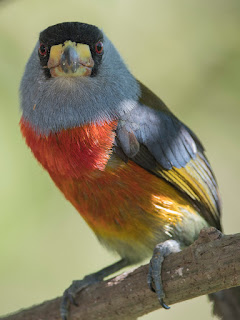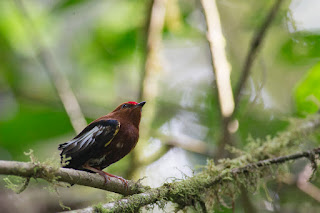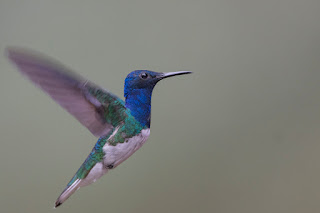Paz de Las Aves
Andean Cock-of-the-Rock
These classic south America symbols are more vibrant than our other target cotinga species, Long-wattled Umbrellabird, on the trip. We arrived at a lek in the dark. And soon all of the male birds started to compete for a branch to call and display on before we could even see them. No females stopped by, but the show still continued for about half an hour, after that the lek quieted down pretty much instantly and the red birds were gone in no time.
Dark-backed Woodquail
feeding beside the Cock-of-the-Rock blind, actually, it was just a very well built roof.
Lyre-tailed Nightjar
After checking the nightjar and Yellow-bellied Antpitta, which was also found at Las Grlarias the day before, we couldn't wait to get breakfast. But the breakfast was not ready, so we watched the birds eat at Paz's feeders.
Andean Emerald edit i think it is booted racket tail
Brown Inca
Booted Racket-tail
the ones west of Andes have white puffs
Purple-throated Woodstar
Buff-tailed Coronet
Fawn-breasted Brilliant
Rufous-tailed Humingbird
Violet-tailed Sylph
Toucan Barbet
Black Vulture
Not a bird, but it can fly.
Bellavista
Plate-billed Toucan
This beautiful toucan moves in groups and can be found in the Mindo area.
Buff-tailed Coronet
The front on view shows a much lighter golden-green on the forehead and throat.
Russet-crowned Warbler
This snake found its way to Las Gralarias where we stayed for a few nights. But I'm the only one in the group that is interested in things without feathers, so I assumed responsibility to photograph this tame creature on the floor.
Aug 30, 2016
Paz
My dad went back to Paz in the early morning for another try at the Andean Cock-of-the-Rock and was rewarded with a few shots.
Andean Cock-of-the-Rock
Milpe
I was happy with the results of Paz in the previous morning so I stuck with the main group and went to Milpe resort. New birds Green-crowned Woodnymph and Green Thorntail instantly came into sight as the feeders are being refilled.
Green-crowned Woodnymph
Green Thorntail
Green-crowned Brilliant
Pale-mandibled Aracari
Rufous Motmot
White-whiskered Hermit
Bananaquit
Streaked Flycatcher
Long-wattled Umbrellabird
This female showed up near the feeders and was a little bit of a surprise for us. We planned on seeing this bird the day after, but all birds are welcome.
Leafcutter ant are quite interesting to watch, partly because of their farming behavior and partly because of their fame.
Edit: How did I forget to post some pics of the star bird at Milpe? Club-winged Manakin
Club-winged Manakin
The males choose branches between 2 and 10 m above the ground with little obstructions around to display. The lekking groups are spread out and each bird has its own trees. The separation between the territories is about 10m or more at this location.
The secondaries and tertials are used as instruments during display.
when the wings of the species are vibrated, probably hooking the tips of feathers together, a unique sound can be heard. A link to Nat Geo's video of the display.
Pacific Hornero
Glad we went back to Las Gralarias for lunch, which yielded this. And it was our only hornero of the trip.
Alambi
Came here in the same afternoon. The feeders and trees are closer to the background than most other places, so the outlines of leaves and branches are a little distracting, but a few angles are still pretty good.
Brown Violetear
White-necked Jacobin
Sparkling Violetear
Rufous-tailed Hummingbird
Purple-throated Woodstar
Lemon-rumped Tanager
male is largely black
Female and juvenile look very different from the adult male.
White-lined Tanager
female
Palm Tanager
Silver-throated Tanager
Black-winged Saltator
Green Honeycreeper
Thick-billed Euphonia
Red-headed Barbet
male on the left, female on the right
Tawny-bellied Hermit
Not sure what this is. Even though I do have a field guide, I can't quite narrow it down.
Another winged creature. Glasswing




























































